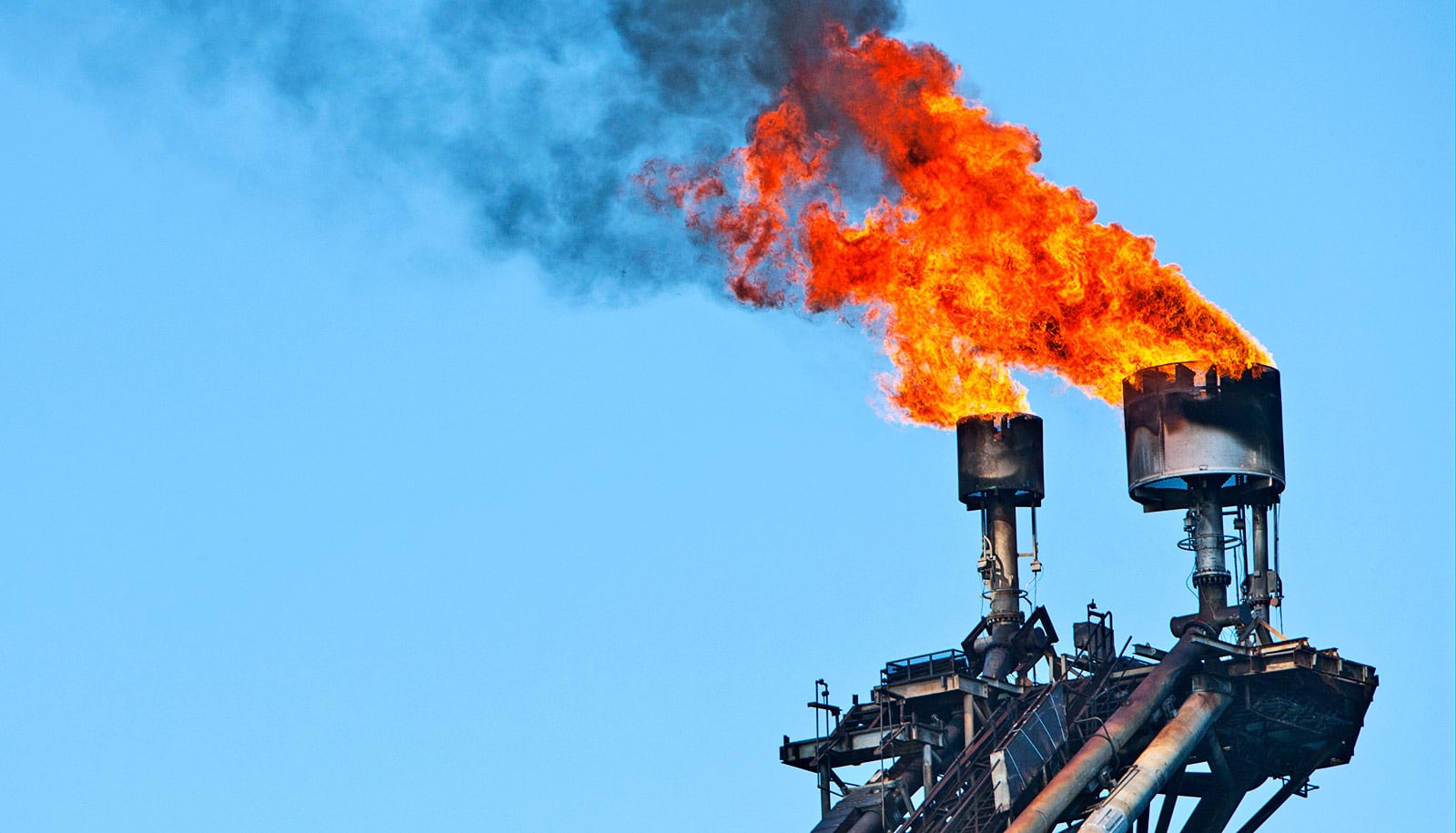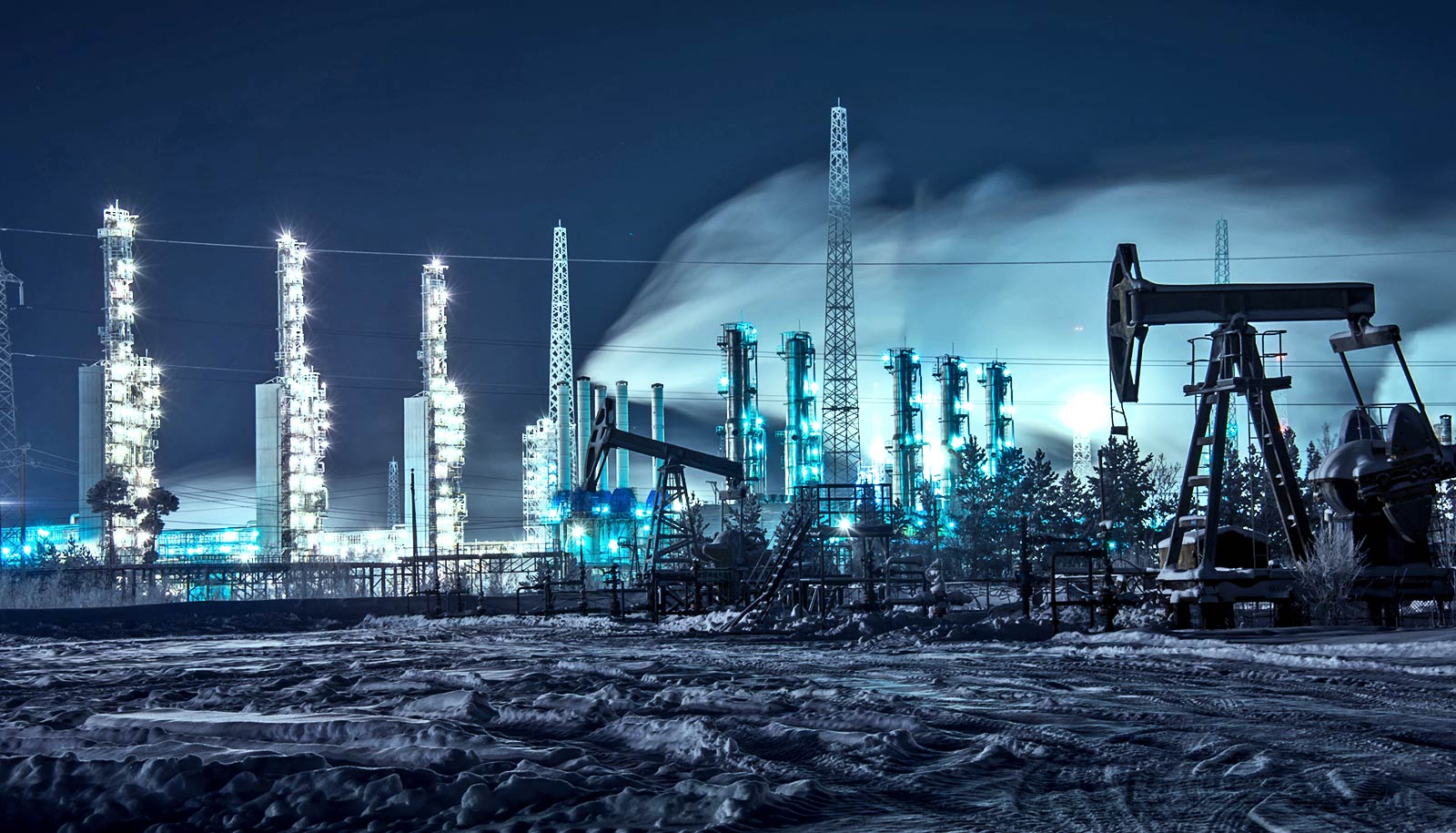The burning of unwanted gas associated with oil production—called “flaring”—remains the most carbon-intensive part of producing oil, according to a new analysis.
Until renewable sources of energy like wind or solar become more reliable and less expensive, people worldwide remain reliant on fossil fuels for transportation and energy. This means that if people want to reduce greenhouse gas emissions, there need to be better ways of mitigating the effects of extracting and burning oil and gas.
Adam Brandt, assistant professor of energy resources engineering in the School of Earth, Energy & Environmental Sciences at Stanford University, and his colleagues have performed a first global analysis comparing emissions associated with oil production techniques—a step toward developing policies that could reduce those emissions.
The group reports that in 2015, nearly 9,000 oilfields in 90 countries produced greenhouse gases equivalent to 1.7 gigatons of carbon dioxide—roughly 5 percent of all emissions from fuel combustion that year. On average, oil production emitted 10.3 grams of emissions for every megajoule of crude. Nations with the most carbon-intensive practices cranked out emissions at nearly twice that rate.
Further, the study suggests that eliminating routine flaring and cutting methane leaks and venting to rates already achieved in Norway could cut as much as 700 megatons of emissions from the oil sector’s annual carbon footprint—a reduction of roughly 43 percent.
Here, Brandt discusses the group’s findings and strategies for reducing flaring.
What is flaring and why is it especially important to track?
Oil and gas are generally produced together. If there are nearby gas pipelines, then power plants, factories, businesses, and homes can consume the gas. However, if you’re very far offshore or can’t get the gas to market, there’s often no economically feasible outlet for the gas. In this case, companies want to get rid of the gas, so they often burn—or flare—it.
Thankfully, there is some value to the gas, so there can be some savings associated with stopping flaring. I think setting the expectation that the gas will be managed properly is the role of the regulatory environment. There are some efforts underway to try to tackle this—the World Bank has a big effort called the Global Gas Flaring Reduction Partnership, where companies have banded together to try to set flaring targets, so hopefully this will start to decline.
This work represents the first study breaking down oil-industry greenhouse gas emissions at the country level. What data did you look at to do this work?
This is the culmination of a larger project we’ve been working on for eight or so years. We used three different data sources. For some countries you can get data from governmental sources or regulatory agencies. Environmental agencies and natural resource agencies will also report information we can use. Otherwise, we go to petroleum engineering literature to get information about oil fields. Then we were able to collaborate with Aramco, an international oil company, to access a commercial data set. That allowed us to fill in gaps for a lot of smaller projects that are harder to get information on or the data gathering was just too intensive.
With that, our paper covers about 98 percent of global oil supply. Necessarily, it’s the first time we’ve been able to do this at this very resolved oil field-by-oil field level.
In mapping the world’s oil supply, how did you estimate emissions from flaring on a country-by-country basis?
One of the challenges with flaring is that most countries don’t report it. In many countries, we ended up using country-level average satellite data collected by the National Oceanic and Atmospheric Administration. Scientists there have developed ways to estimate the amount of gas flared using the brightness of the flare as seen from space. It’s essentially an eye in the sky. For instance, Russia won’t say how much they are flaring, but we can see it from the satellite.
Where have you seen flaring regulations work?
Offshore Canada has had a good success over the last 15 years. Basically, the rules there say that you’re not allowed to flare above a certain amount. If flaring goes above a permitted level, Canada requires their offshore fields to shut down until they handle the gas. This can be done by reinjecting it back into the ground, converting it to liquefied natural gas or installing gas pipelines to get the gas to customers.
Canadian flaring has dropped significantly, and these regulations prove that you can manage flaring and require that people do something productive with the gas or put it back underground. Really, the challenge with flaring is there needs to be a policy or a regulatory apparatus to say, “Burning gas with no purpose isn’t allowed; put it back in the ground or find something useful to do with it.”
In the absence of federal action, how can we prioritize flaring reductions here in the US?
If you don’t see action at the US federal level, you can work with leadership from state agencies. A good example of this was the state of North Dakota. North Dakota contains the Bakken Formation, which is one of the main regions for producing oil from hydraulically fractured wells.
Five years ago, 30 percent of the gas being produced was being flared, and essentially the state government said this is not acceptable. Thirty percent was way too high and the gas had value—it could be sold to cities like Chicago, Calgary, or Denver. The government set a target for 10 percent, with the threat of potential production restrictions if producers didn’t meet the target.
So what happened? Producers in the region actually met the 10 percent target ahead of time. So I think things can keep moving forward. Obviously, it’d be better if we had some sort of federal action on this, but states can do a lot.
Who can drive the change needed across the globe?
Globally, I think international oil companies can really take the lead. A lot of the projects with flaring are in countries where environmental issues are poorly regulated. But many of these projects are developed by the local national oil company in cooperation with international partners.
It’s hard to wait on developing countries without large budgets or sophisticated regulatory capacity to put flaring rules into place. Instead of waiting for that to happen, we might expect the international oil companies work to solve the problems themselves by applying best practices from places were regulations have already solved the problem. For example, companies in Nigeria have increased gas reinjection and developed liquefied natural gas projects to get the gas to markets.
In the coming decades, we are going to be using a lot of oil and gas. It’s inevitable. Taking best practices and applying them in places that are not as well regulated right now—but hopefully will be—can allow improvements in one region to benefit another region.
Hopefully, we’ll transition as quickly as possible to renewables, but while we use oil and gas in the meantime, let’s do it responsibly.
Additional coauthors are from Aramco Services Co., Ford Motor Co., the University of Calgary, the Carnegie Endowment for International Peace, Carnegie Mellon University, University of British Columbia, California Environmental Protection Agency, National Renewable Energy Laboratory, University of Michigan, International Energy Agency, Baker Hughes, Chalmers University of Technology, Cornell University, and Argonne National Laboratory.
The Natural Sciences and Engineering Research Council of Canada, Aramco Services Co., Ford Motor Co., the Carnegie Endowment for International Peace, the Hewlett Foundation, the ClimateWorks Foundation, and the Alfred P. Sloan Foundation funded the work.
The analysis appears in Science.
Source: Katie Brown for Stanford University

